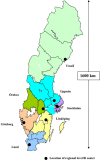EXPRESS study shows significant regional differences in 1-year outcome of extremely preterm infants in Sweden
- PMID: 24053771
- PMCID: PMC4034585
- DOI: 10.1111/apa.12421
EXPRESS study shows significant regional differences in 1-year outcome of extremely preterm infants in Sweden
Abstract
Aim: The aim of this study was to investigate differences in mortality up to 1 year of age in extremely preterm infants (before 27 weeks) born in seven Swedish healthcare regions.
Methods: National prospective observational study of consecutively born, extremely preterm infants in Sweden 2004-2007. Mortality was compared between regions. Crude and adjusted odds ratios and 95% CI were calculated.
Results: Among 844 foetuses alive at mother's admission for delivery, regional differences were identified in perinatal mortality for the total group (22-26 weeks) and in the stillbirth and perinatal and 365-day mortality rates for the subgroup born at 22-24 weeks. Among 707 infants born alive, regional differences were found both in mortality before 12 h and in the 365-day mortality rate for the subgroup (22-24 weeks) and for the total group (22-26 weeks). The mortality rates were consistently lower in two healthcare regions. There were no differences in the 365-day mortality rate for infants alive at 12 h or for infants born at 25 weeks. Neonatal morbidity rates among survivors were not higher in regions with better survival rates. Perinatal practices varied between regions.
Conclusion: Mortality rates in extremely preterm infants varied considerably between Swedish healthcare regions in the first year after birth, particularly between the most immature infants.
Keywords: Cohort study; Extremely preterm infant; Morbidity; Mortality; Outcome.
©2013 Foundation Acta Paediatrica. Published by John Wiley & Sons Ltd.
Figures



Comment in
-
Bringing transparency into quality comparison research.Acta Paediatr. 2014 Jan;103(1):19-21. doi: 10.1111/apa.12480. Acta Paediatr. 2014. PMID: 24148182 No abstract available.
-
Interpreting regional differences in neonatal outcomes for extremely preterm babies.Acta Paediatr. 2014 Jan;103(1):4-5. doi: 10.1111/apa.12518. Acta Paediatr. 2014. PMID: 24354571 No abstract available.
References
-
- Markestad T, Kaaresen PI, Ronnestad A, Reigstad H, Lossius K, Medbø S, et al. Early death, morbidity, and need of treatment among extremely premature infants. Pediatrics. 2005;115:1289–98. - PubMed
-
- Tommiska V, Heinonen K, Lehtonen L, Renlund M, Saarela T, Tammela O, et al. No improvement in outcome of nationwide extremely low birth weight infant populations between 1996–1997 and 1999–2000. Pediatrics. 2007;119:29–36. - PubMed
-
- The EXPRESS Group. One-year survival of extremely preterm infants after active perinatal care in Sweden. JAMA. 2009;301:2225–33. - PubMed
Publication types
MeSH terms
LinkOut - more resources
Full Text Sources
Other Literature Sources

